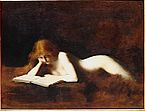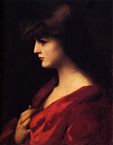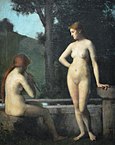Jean-Jacques Henner
You can help expand this article with text translated from the corresponding article in French. (March 2022) Click [show] for important translation instructions.
|
Jean-Jacques Henner | |
|---|---|
 Photograph by Nadar (c.1900) | |
| Born | 5 March 1829 |
| Died | 23 July 1905 (aged 76) |
| Nationality | French |
| Occupation | Painter |
Jean-Jacques Henner (5 March 1829 – 23 July 1905) was a French painter, noted for his use of sfumato and chiaroscuro in painting nudes, religious subjects and portraits.
Biography

Henner was born at Bernwiller (Alsace). He began his studies in art as a pupil of Michel Martin Drolling and François-Édouard Picot. In 1848, he entered the École des Beaux Arts in Paris, and took the Prix de Rome with a painting of Adam and Eve finding the Body of Abel in 1858. In Rome, he was guided by Flandrin, and painted four pictures for the gallery at Colmar among other works.
He first exhibited Bather Asleep at the Salon in 1863 and subsequently contributed Chaste Susanna (1865), now in the Musée d'Orsay. Other noted works include: Byblis turned into a Spring (1867); The Magdalene (1878); Portrait of M. Hayem (1878); Christ Entombed (1879); Saint Jerome (1881); Herodias (1887); A Study (1891); Christ in His Shroud and a Portrait of Carolus-Duran (1896); a Portrait of Mlle Fouquier (1897); and The Dream (1900).
The Levite of the Tribe of Ephraim (1898) was awarded a first-class medal. Among other professional distinctions, Henner also took a Grand Prix for painting at the Paris Exposition Universelle of 1900. He was made Chevalier of the Legion of Honour in 1873, Officer in 1878, and Commander in 1889. In 1889, he succeeded Cabanel in the Institut de France. Henner's most widely known work is his 1885 painting of Saint Fabiola. Although the original is now lost, it was copied by artists around the world for devotional purposes. Artist Francis Alÿs has collected over 500 copies of the painting in a variety of media. The collection is known as the "Fabiola Project".[1]
Henner died at age 76 in Paris.
Pupils
Henner had numerous pupils; among them were the American painter Mathilde Mueden Leisenring[2] and the Romanian artist Dimitrie Serafim. From 1874 to 1889, organized with Carolus-Duran, what he called "the studio of the ladies" for women were not allowed entry to the École des Beaux-Arts. Some also served as his models. One of these was Dorothy Tennant who later married Henry Morton Stanley.[3]
Another pupil was Elizabeth Snowden Nichols Watrous (1858–1921), later the wife of artist Harry Watrous. Henner gave them a painting when they were married in 1887.[4]
Suzanne Valadon (1865–1938) also worked as one of his models.
Bibliography
- E Bricon, Psychologie d'art (Paris, 1900); C Phillips, Art Journal (1888)
- Frederick Wedmore, Magazine of Art (1888).
- Isabelle de Lannoy, Catalogue raisonne Jean-Jacques Henner 1829-1905 [2008]
Gallery
-
Reclining Nude,
National Gallery of Art, Washington, D.C. -
Woman on a Black Divan,
Musée des Beaux-Arts, Mulhouse -
La liseuse,
Musée d'Orsay,
Paris -
Nus féminins
Musée d'Orsay,
Paris -
Jésus au tombeau
Musée d'Orsay,
Paris -
Portrait d'homme
Musée d'Orsay,
Paris -
Portrait of a Young Girl with a Bow in Her Hair, private collection
-
Alsatian Girl,
National Gallery of Art, Washington, D.C. -
Saint Fabiola
copy of lost original -
Study of a Woman in Red, The Hermitage,
St. Petersburg, Russia -
A Red-Haired Beauty,
private collection -
Head of a Girl - Brooklyn Museum
-
The Chaste Susannah
Musée d'Orsay,
Paris -
Le réveil de l'enfant
Musée des Beaux-Arts, Dijon -
Penitent Magdalene,
private collection - Cantor Arts Center, Stanford, California -
Idylle
Musée d'Orsay,
Paris
See also
References
- ^ "Francis Alys The Fabiola Project". The Menil Collection. Retrieved 18 January 2019.
- ^ Andrew J. Cosentino (17 November 1983). The Capital Image: Painters in Washington, 1800–1915. Smithsonian. ISBN 978-0-87474-338-8.
- ^ w:fr:Jean-Jacques Henner
- ^ "Elizabeth Watrous, Painter, is Dead," American Art News, Vol. 20, No. 2 (Oct. 22, 1921), p. 6.
This article incorporates text from a publication now in the public domain: Chisholm, Hugh, ed. (1911). "Henner, Jean Jacques". Encyclopædia Britannica. Vol. 13 (11th ed.). Cambridge University Press. p. 272.
![]() Media related to Jean-Jacques Henner at Wikimedia Commons
Media related to Jean-Jacques Henner at Wikimedia Commons
- 1829 births
- 1905 deaths
- 19th-century French painters
- 20th-century French painters
- 20th-century French male artists
- Academic art
- French male painters
- Members of the Académie des beaux-arts
- Painters from Alsace
- People from Haut-Rhin
- Prix de Rome for painting
- French portrait painters
- 19th-century French male artists

















